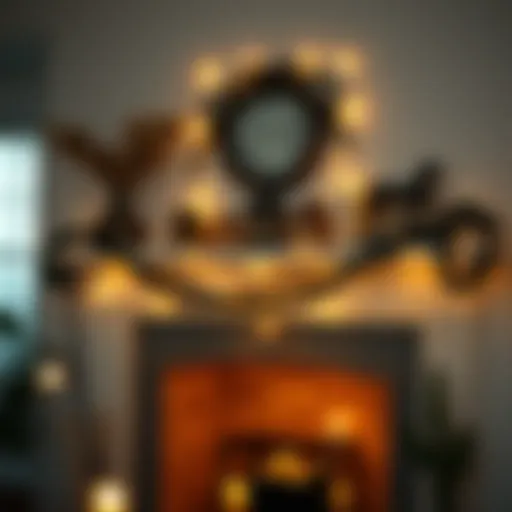Men's Pilot Costumes: Trends and Craftsmanship Insights
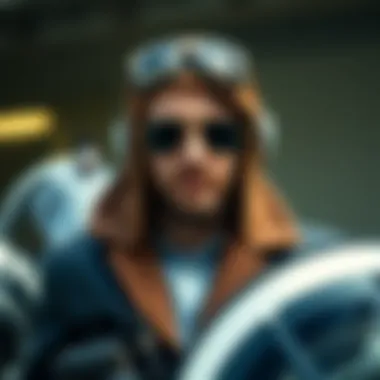

Intro
Men's pilot costumes carry a certain allure, intertwining the threads of history, fashion, and culture. They represent more than mere attire; they symbolize adventure, exploration, and the rugged charm of the skies. As one delves into the craftsmanship behind these outfits, there’s an unexpected blend of tradition and modern sensibilities, each stitch reflecting a journey through time.
Fashion Trends
The fashion landscape for men's pilot costumes has seen considerable evolution, shifting from utilitarian roots to contemporary fashion statements.
Latest Seasonal Trends
Recently, pilot-inspired garments have taken center stage in several high-end fashion shows. Think leather jackets, tailored trousers, and rugged boots, all adorned with subtle details like patches reminiscent of vintage aviation. This season’s palette tends to include earth tones—rich browns, deep greens, and the occasional splash of navy. These colors not only echo the natural landscapes experienced during aerial adventures but also make for versatile pieces suitable for various occasions.
Iconic Styles Revived
In the reimagining of classic pilot styles, many designers draw influence from the World War era. The bomber jacket, popularized during those times, has reclaimed its position in modern wardrobes, often paired with sleek chinos or jeans. The aviation jumpsuit, once associated with fieldwork, has transitioned into a fashion staple, showcased in various cuts and fabrics—from lightweight cotton blends to luxurious silk.
"Fashion is a reflection of our times, and just as pilots soared into the skies, our wardrobes evolve with the spirit of adventure."
Style Tips
Navigating the world of men's pilot costumes can be tricky. Thankfully, practical advice can help wearers strike the right balance between style and function.
How to Mix and Match
To effectively pull off a pilot-inspired look, start with a key piece—be it a leather jacket or an aviator cap. Here are some pairing tips:
- Layering: A well-fitted shirt underneath a rugged jacket can elevate the whole ensemble. Aim for monochromatic patterns or subtle hues.
- Footwear Matters: Sturdy boots not only enhance comfort but also solidify the look. Avoid anything overly flashy; keep it simple.
- Accessorize Wisely: Incorporate accessories like vintage aviator sunglasses or a leather messenger bag to complete the outfit. These details add character without overshadowing the main pieces.
Dressing for Different Occasions
While pilot costumes are inherently stylish, they require thoughtful consideration based on the event:
- Casual Outings: A leather jacket with jeans can be the perfect choice for brunch or a night out.
- Professional Settings: Opt for tailored slacks and a sleek shirt, topping it off with a lightweight bomber for a polished yet relaxed feel.
- Special Occasions: A high-quality aviator jumpsuit can command attention at parties, especially when combined with clean-cut shoes and minimalist accessories.
The allure of men's pilot costumes lies in their capacity to adapt and inspire. From rugged to refined, there’s an option for every taste, underscoring the importance of style rooted in history and craftsmanship. As fashion evolves, so does the appreciation for garments that tell a story.
The Origins of Pilot Costumes
The journey of men’s pilot costumes is not just about fabric and thread; it’s an elaborate tapestry woven from history, culture, and innovation. Understanding the origins of these outfits lays the groundwork for discerning their evolving significance in fashion and identity. In exploring pilot costumes, we unearth layers of meaning that extend beyond mere style. This rich foundation informs both contemporary designs and cultural impacts associated with airline uniforms today.
Historical Context
To truly appreciate modern pilot attire, one must look back at its roots. The early days of aviation were rife with practical challenges that shaped what pilots wore. During World War I, for instance, pilots donned sturdy leather jackets for warmth and protection against the elements. These early garments were not just about aesthetics; they were necessities in a time when aviation was still courting danger.
Post-war, as aviation became accessible to the public, the pilot uniform began to take form. The design started to incorporate more stylish elements while still serving its original function. With the advent of commercial airlines in the mid-20th century, uniforms adopted a more polished appearance to convey professionalism and authority to passengers.
The evolution during this period can be likened to dressing for a job interview—first impressions matter intensely. The crisp white shirts and dark trousers became the hallmark of a pilot’s ensemble, exuding both cleanliness and reliability.
Evolution Through Decades
As time marched on, so did pilot uniforms. The 1960s and 1970s brought a wave of fashion consciousness to the cockpit. Airlines began to personalize their uniforms with unique insignias and embellishments. Pilots weren’t just seen as operators of the aircraft but rather as brand ambassadors, leading to a playful mix of traditional and modern styles.
By the 80s and 90s, practicality combined with fashion statements, where pilots attempted to express individuality while adhering to their company’s guidelines. High-quality materials became more accessible, impacting craftsmanship and enhancing comfort during long flights. Innovations like flight jackets began incorporating materials previously deemed unconventional for work attire, signaling a shift towards a more relaxed yet professional style.
Iconic Pilot Attire in Media
Media representations have played an important part in popularizing pilot costumes. Films and television shows often showcase pilots as figures of authority and charisma. Think of Tom Cruise in Top Gun, donning a flight suit that became iconic not due to its practicality but through the charisma and confidence it imbued. This portrayal has created a romantic notion around the life of a pilot that continues to influence fashion.
Moreover, advertising campaigns by airlines have historically presented pilots in an aspirational manner. Airlines like British Airways and Qantas have constructed their brand images around the meticulous attention to details in their uniforms, blending tradition with modernity. The polished look of a pilot often evokes an array of feelings, encapsulating safety, adventure, and prestige.
In summation, the origins of pilot costumes are deeply rooted in historical evolution, cultural significance, and media manifestations. This understanding equips stylists, designers, and fashion aficionados with a layered perspective essential for engaging with contemporary pilot costumes. As the narrative around men’s pilot attire unfolds, it highlights a continuous interplay of aesthetics and practicalities, illustrating why these garments captivate and inspire a diverse audience.
Key Elements of a Pilot Costume
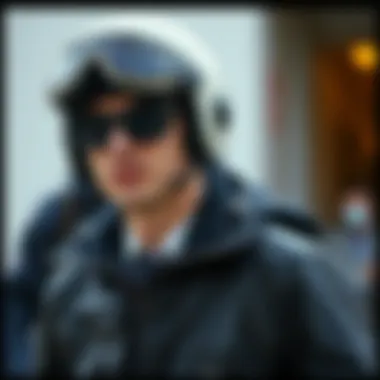

When one thinks about a pilot’s costume, the mind often wanders to uniforms that ooze authority and professionalism. But beyond mere aesthetics, the key elements of a pilot costume play a crucial role in both function and fashion, creating a unique blend that speaks to style, identity, and tradition.
A pilot's outfit is not just a collection of different garments, but rather a carefully curated ensemble that conveys not only the pilot's role but also the airline’s identity. The components of these outfits often include flight jackets, pants or uniforms, and a myriad of accessories, each with its own significance and practicality. Understanding these elements elevates the appreciation of pilot costumes and highlights their importance in modern fashion.
Flight Jackets
Flight jackets stand at the forefront of any pilot costume. They are not just protective clothing but also a style statement that reflects a pilot's rugged charm. Their popularity can be attributed to their durability and versatility, allowing them to traverse both the cockpit and the fashion scene seamlessly.
Types of Flight Jackets
There are various types of flight jackets available today, each serving a unique purpose. The classic bomber jacket, originally designed for pilots during WWII, has survived the test of time due to its functionality and style. The design's key characteristic—the ribbed cuffs and waistband—ensures a snug fit, protecting the wearer against the elements, while offering a timeless look.
Another type is the leather flight jacket, which provides both warmth and an undeniable aura of sophistication. This stylish exterior is a favored choice among fashion-forward individuals looking to make a statement. A unique feature of these jackets is their aging process; over time, they develop a beautiful patina, adding character and individuality.
Each type of flight jacket has its benefits and disadvantages, with wearability being a significant factor in their popularity. For instance, bomber jackets are light and comfortable but may not provide enough insulation in frigid climates. On the flip side, leather jackets can be heavy and uncomfortable at times, especially in warmer weather.
Materials Used in Flight Jackets
The materials used in crafting flight jackets are as diverse as their styles. Leather, nylon, and polyester are commonly used, each bringing a unique attribute to the table. Leather, being both sturdy and stylish, is often seen in high-end designs. Its significant longevity makes it an appealing choice for both pilots and designers alike. However, maintenance can be onerous, needing special care to maintain its sleek appearance.
Nylon, on the other hand, is a lightweight option favored for its water-resistant properties. Its ease of care contributes to its growing popularity among modern pilots who prefer function over form. A downside to nylon, however, is that it may not offer the same classic look that leather does. The balance of durability versus style is a keen consideration for those selecting flight jackets.
Pants and Uniforms
Pants and uniforms are equally important as they provide the necessary comfort and functionality that pilots need. A well-structured uniform creates cohesion and reflects the airline’s brand. Trousers that fit well and are made from breathable materials ensure pilots remain at ease during long flights. Whether it’s the traditional dark slacks or a modern take with casual stylings, the choice of pants completes the pilot’s look while serving practical purposes necessary for their demanding roles.
Accessories and Insignia
Accessories and insignia are the final touches that can’t be overlooked. They offer personal flair and signify rank and service history.
Caps and Helmets
Caps and helmets are critical accessories often worn by pilots. A pilot's cap, curved with a structured brim, symbolizes authority. It's more than just a fashionable piece; it represents the dedication and achievements of the wearer. The unique feature of a pilot's cap is the embroidered insignia that denotes their qualifications and status.
However, wearing caps can be subjective; some may find them a bit confining or uncomfortable. Helmets, typically used in military aviation, are equipped with protective features that can be bulky at times, but they ensure the highest degree of safety during flight.
Badges and Patches
Badges and patches are another layer to pilot costumes. These elements provide insight into the wearer’s achievements, training, and affiliations. Badges often reflect the airline they serve, while patches might denote specific missions or accomplishments. Their visual impact brings a sense of pride to the wearer.
While these items are intended to convey status and expertise, they can also overwhelm the uniform if not balanced correctly. The key here is moderation: a couple of tasteful insignias can enhance an outfit, while an overload can detract from the elegance of a pilot costume.
Modern Trends in Men's Pilot Costumes
The modern landscape of men's pilot costumes is a blend of functionality, style, and cultural significance, reflecting not only the needs of contemporary aviators but also the broader society's engagement with aviation. This section highlights how fashion is continuously evolving, adapting to both practical demands and style preferences. With burgeoning trends, the importance of pilot costumes transcends mere utility, embracing a unique narrative that merges historical resonances with modern aesthetics.
Fashion Adaptations
Casual Interpretations of Pilot Costumes
In today's fast-paced world, casual interpretations of pilot costumes have taken flight. This trend brings a laid-back charm to traditionally formal attire. Think along the lines of bomber jackets paired with tailored chinos—this blend strikes a balance between comfort and sophistication. The key characteristic of these casual adaptations is their versatility: suitable for both weekend outings and relaxed work environments.
One particular advantage this style offers is its approachability; you don't need a pilot's license to rock the look. Instead, style enthusiasts can channel the essence of aviation without losing comfort. However, it can sometimes challenge the boundaries of professionalism—essentially walking a tightrope between looking casual and maintaining a polished appearance.
High Fashion Influences
On the opposite end of the spectrum, high fashion has also nudged its influence into the world of pilot attire. Major designers have incorporated aviation-themed designs into their collections, turning the spotlight onto luxurious fabrics and cutting-edge tailoring. This trend represents a shift towards high-end interpretations of pilot costumes, making them desirable pieces for fashion-forward individuals.
A standout characteristic of high fashion influences is the incorporation of avant-garde elements, such as unique fabric choices and bold patterns, which give traditional looks a modern twist. This not only breathes new life into classic styles but also elevates them to the status of wearable art. However, the downside often lies in accessibility; while these designs are visually stunning, they come with hefty price tags.
Cultural Relevance
Pilot Costumes on Runways
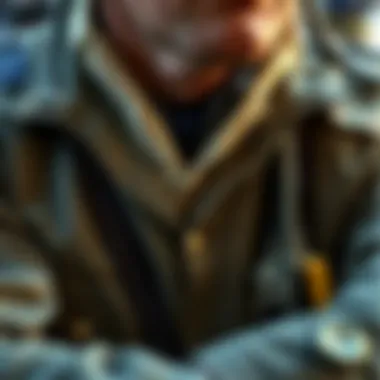

When we look at the fashion runway scene, pilot costumes no longer remain the hidden gems of the aviation world; they take center stage, capturing the attention of designers and audiences alike. Shows like Paris Fashion Week increasingly showcase collections inspired by pilot attire, placing these designs in the spotlight and emphasizing their cultural resonance in modern society.
A defining characteristic of these presentations is their ability to evoke nostalgia while simultaneously driving forward contemporary fashion narratives. By blending elements like classic flight jackets with avant-garde tailoring, designers craft a visual dialogue that resonates deeply with audiences. With such visibility, the pilot costume phenomenon signals a growing recognition of aviation as a cultural symbol, not just a practical uniform. However, this trend is a double-edged sword; as pilot costumes become highly stylized, their original practical functions may become overshadowed.
Impact of Pop Culture
Pop culture has a knack for redefining narratives, and pilot costumes are no exception. Movies, television series, and even music videos from the likes of K*pop artists have made pilot costumes wildly popular among fans. This influence often injects a new life into what was once purely utilitarian garb, transforming it into an aspirational wardrobe component.
The key characteristic of pop culture's influence on pilot attire is the aspirational quality it imbues—many fans strive to emulate the looks they've seen on-screen or during public performances. Not only does this increase interest in pilot costumes, but it also fosters a sense of community among followers. The potential downside, however, is that focuses on style over substance could lead to a dilution of the meaning behind these costumes.
"Fashion is a reflection of our times; it shapes and is shaped by culture, and the evolution of pilot costumes is a prime example of how closely linked these elements are."
As we navigate through these modern trends, it's clear that pilot costumes have evolved to embody more than just uniformity. They represent an ongoing dialogue between history, culture, and modern style. Each adaptation and trend holds significance, not just for those in the skies, but for society as a whole.
Significance of Pilot Costumes Today
Pilot costumes hold a weightier significance in today's world than mere attire for aviation professionals. They emerge as powerful symbols of tradition, authority, and even identity. Not only do they signify a profession marked by skill and precision, but they also showcase how fashion intertwines with cultural notions and societal values. The pilot costume encapsulates the narrative of adventure and exploration while embodying rigorous standards of professionalism. Let's unpack these essential elements further.
Symbolism in Apparel
Authority and Power
When discussing authority in apparel, pilot costumes are prime examples. The sharp lines of a crisp uniform paired with distinctive insignia don’t just serve a functional purpose but resonate deeply with the perception of power. This kind of attire is often associated with decision-makers—you see it in boardrooms as well as flight decks. The pilot’s uniform conveys a sense of reliability, instilling confidence among passengers. Its key characteristic lies in how these garments communicate proficiency.
Should a passenger spot a pilot in uniform, there's often an immediate psychological response. The ensemble is more than just fabric; it signifies a commitment to safety. In this article, this characteristic is deemed beneficial, as it enhances the perceived efficacy of airline operations. Furthermore, wearing such attire elevates self-confidence, both for the wearer and the perceiver, maintaining a distinct advantage in the aviation industry.
However, such authority can come with pressures as well. With this commanding image, there’s an expectation of perfection. One minor mistake and the public's confidence can waver. While this high standard is necessary for safety, it can add stress on practitioners wearing the uniform.
Cultural Identity
Pilot costumes also forge a unique identity. They encapsulate cultural narratives and signify regional identities that transcend geographical boundaries. In countries where aviation serves as a vital link to modernization and growth, the pilot costume symbolizes aspirations and potential.
The key characteristic of cultural identity in pilot costumes is their adaptability to local contexts. While certain elements remain universally recognized, such as the presence of insignia or caps, additional features may highlight local heritage—perhaps through colors, patterns, or textiles. This characteristic allows for a depiction of pride and local essence, making the attire not just a uniform, but a manner of representing diversity and unity.
A uniqueness to consider is how pilot costumes are interpreted differently across various cultures. In places like Japan, there is a special emphasis on neatness and presentation, while in the West, it might emphasize individuality and functional design. This adaptability grants significance, often enhancing connections between the pilot and the community they serve.
Role in Fashion and Industry
Pilot costumes have also made their stamp in the broader landscape of fashion. High fashion houses reference pilot attire, merging functionality with connective elegance. This trend expands beyond runways into retail, affecting how everyday consumers perceive and adopt similar styles.
The industry’s recognition of pilot costumes reflects a dual nature—they are at once utilitarian yet stylistically noble. They present a fine balance between practicality for pilots and aspiration for the general public. The evolution of pilot costumes fuels ongoing discussions in both fashion and aviation, influencing future designs that captivate contemporary audiences.
Through this exploration, one can see that pilot costumes, more than anything, are multifaceted. They carry heritage, authority, and cultural sentiment while shaping modern trends in style. As we journey through this compelling world, understanding their significance only strengthens the bond between fashion and the vital role of aviation.
Craftsmanship Behind Pilot Costumes
Craftsmanship plays a pivotal role in the world of pilot costumes, intertwining functionality with aesthetic appeal. It's not merely about the outer appearance of these outfits, but also how they serve the needs of the wearer. A well-crafted pilot costume can enhance the professional look while ensuring comfort during long hours in the cockpit or events. The intersection of quality materials and skilled tailoring are what define a standout pilot uniform, laying the foundation for subsequent fashion trends.
Materials and Fabrics
Sustainability Considerations
In today's climate-conscious world, sustainability in fashion is gaining momentum. For pilot costumes, materials like organic cotton or recycled polyester are becoming more prevalent. The significance of sustainability is not just ethical; it often leads to healthier manufacturing processes and a lower carbon footprint.
A key characteristic of sustainable materials is their ability to reduce environmental harm while providing durability and comfort. When manufacturers choose eco-friendly fabrics, they offer aesthetic options without sacrificing quality.
The unique feature of sustainable fabrics is their versatility. Fabrics derived from sources like bamboo or hemp can be made both lightweight and breathable, essential for pilots who need comfort as well as a polished look. However, it’s important to note that sustainable fabrics can sometimes come at a higher cost due to sourcing and production standards. The balance between choosing eco-friendly options and keeping within a budget is a consideration for fashion designers and consumers alike in the pilot costume realm.
Quality vs. Cost
When it comes to pilot costumes, the conversation between quality and cost is always buzzing. Selecting high-quality materials may lead to a higher price tag. However, it often means that the endurance and longevity of the uniform are positively impacted. Investing in quality ensures that the pilot is not merely buying a uniform for a season, but for many flights to come.
A key feature of high-quality materials is their ability to withstand wear and tear, maintaining their shape and color under changing conditions. This is especially critical for pilots who may be exposed to varying climates on different routes.
On the flip side, cost is an undeniable factor in any fashion decision. Companies offering lower-priced uniforms might compromise on fabric quality or craftsmanship, leading to quicker wear and the need for replacements. Designers must navigate this intricate landscape, balancing beauty, durability, and budget constraints, to produce garments that pilots can feel proud to wear.
Tailoring Techniques
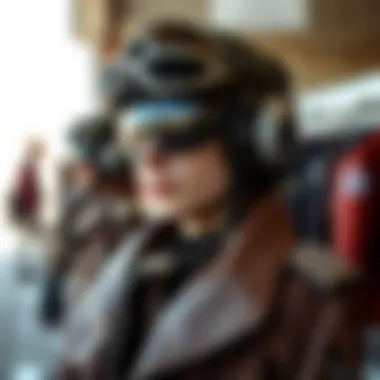

Tailoring in the realm of pilot costumes is an art form that cannot be underestimated. Effective fitting techniques influence how the pilot presents their look as much as the materials used. The right tailoring can accentuate the body structure while ensuring ease of movement, which is vital for pilots engaged in their duties.
To achieve that tailored look, precision in measurements is key. Techniques such as darting and pleating are frequently used to achieve that seamless fit, especially around the shoulders and waist, critical areas for comfort and ease of movement during flight. Furthermore, the positioning of pockets, zippers, and other elements can drastically affect both functionality and style.
In summary, craftsmanship behind pilot costumes is a blend of superior materials and expert tailoring techniques. As the fashion landscape evolves, understanding the relationship between handiwork and the requirements of aviation helps designers push boundaries, all while creating uniforms that remain timeless yet modern.
The merging of sustainable practices with enduring quality is paving the way for a future where pilot costumes embody both responsibility and elegance.
Styling Tips for Wearing Pilot Costumes
When it comes to men’s pilot costumes, knowing how to style them can significantly enhance their impact. These outfits carry a rich history and convey a sense of authority. The way one pairs them with different elements can make or break the entirety of the look. Styling tips not only contribute to the aesthetic appeal but also help wearers navigate various settings—be it casual meet-ups or more formal gatherings.
Ultimately, the right styling choices can elevate the everyday man’s wardrobe into something remarkable.
Pairing with Other Attire
Mixing Casual and Formal Styles
Mixing casual and formal styles within the realm of pilot costumes offers a fascinating opportunity for personal expression. This blend allows individuals to maintain the structured essence associated with pilot attire while introducing an element of comfort and ease. For example, pairing a classic bomber jacket with tailored chinos can strike an engaging balance that feels fresh.
The key characteristic of this mix is the ability to adapt to diverse environments. So whether one is going for a coffee run or attending a dinner party, this versatile approach can settle right in. It’s a beneficial choice for those looking to break the mold of traditional formal wear without losing sophistication.
However, a major disadvantage might be the potential to disrupt the classic look associated with pilot costumes. Too much casualness can dilute the intended authority. Therefore, thoughtful consideration is crucial when making these fashion choices.
Seasonal Adaptations
Embracing seasonal adaptations is another essential aspect when it comes to wearing pilot costumes. Different weather conditions often require adjustments in layering and fabric selection. For instance, opting for lighter materials like cotton in summer and heavier fabrics like wool in winter can ensure comfort without sacrificing style.
A key element of this practice is its benefit in functionality. It allows wearers to keep in step with changing seasons while remaining fashionable. Plus, when considering pilot costumes, one might even explore seasonal colors—earthy tones in the fall, fresh whites and blues in summer—adding an extra layer of depth to the outfit.
Nevertheless, one of the unique features of seasonal adaptation is the challenge of maintaining the outfit’s integrity across different environments. Certain styles may get lost when adjusted for weather, rendering them less representative of the classic pilot look. This is a balance that every fashion enthusiast must navigate as they seek to integrate these adaptations into their wardrobes.
Footwear Choices
Another crucial element in the overall aesthetic of pilot costumes is the choice of footwear. Selecting the right shoes can solidify the look and complement the overall style. Casual boots can lend a rugged edge, while polished shoes can add a streamlined finish suitable for formal occasions. Consideration of the footwear not only reflects personal style but also influences comfort levels throughout the day. Different scenarios call for different shoes, making this an important factor in the complete ensemble.
By weaving in these styling tips, wearers can truly maximize the potential of their pilot attire, ensuring it not only honors tradition but also embraces personal flair.
Future Trends in Pilot Costumes
As we look ahead, the landscape of men's pilot costumes is poised for transformation. The importance of recognizing these upcoming trends goes beyond mere aesthetics; it taps into the evolving identities and roles that aspiring masculinities play within both aviation and fashion. The convergence of traditional craftsmanship with modern innovations shapes not only what pilots wear but also how they are perceived. By examining factors such as innovation in design and global influences, we can foresee a direction that balances functionality with an eye on style.
Innovation in Design
Smart Fabrics
One of the defining aspects of modern pilot costumes lies in the advent of smart fabrics. These textiles are engineered to offer more than just comfort; they can regulate temperature, wick away moisture, and even provide UV protection. What makes smart fabrics particularly appealing is their versatility. For instance, an aviator's outfit may now include features that help manage different climate conditions without sacrificing the classic pilot appearance.
In terms of popular choices, companies are integrating these fabrics into uniforms, ensuring that pilots can perform with both style and effectiveness. A unique characteristic of smart fabrics is their ability to adapt, which can lead to improved performance during long flights.
However, it's worth mentioning that these innovations do come with challenges, such as costs. For some, sourcing high-quality smart fabrics may stretch the budget, pushing them toward more traditional options. Nevertheless, the benefits frequently outweigh these hurdles, making them a desirable choice in the fashion spectrum.
Tech Integration
Tech integration represents another exciting avenue in the evolution of pilot costumes. We are seeing a surge in wearable technology, ranging from communication devices to navigation aids seamlessly incorporated into pilot uniforms. This trend reflects the need for enhanced connectivity and situational awareness in aviation today.
The key characteristic of tech integration in fashion is its practicality. Imagine uniforms equipped with built-in communication systems, allowing seamless interactions among crew members. Such innovations indeed promote safety and efficiency in the skies while keeping fashion relevant.
Yet integrating technology into clothing isn’t without its downsides; technical issues could arise, leading to distractions. There’s also a balance that must be struck between stylish appearances and functional gear. Careful design choices must ensure tech does not compromise the aesthetic qualities that define pilot attire.
Global Influence on Design
In a world that connects cultures like never before, global influences are beginning to shape pilot costume designs significantly. Regions known for specific aesthetic philosophies in fashion are merging with aviation wear, leading to eclectic designs that reflect a broader interpretation of what a pilot can embody.
For example, traditional elements from Japanese streetwear have made their mark on how younger generations perceive pilot aesthetic. There is an increasing desire for uniforms that tell stories, and global fabrics are serving as backdrops to these narratives. Stylish cuts, vibrant colors, and unique patterns may soon define the future of pilot costumes, merging cultural references with functionality.
Moreover, social media plays a role in pushing these trends further, as influencers advocate for these innovative styles. As communities explore their identities, pilot costumes will undoubtedly evolve along with them. This evolution not only showcases the diversity of influences but also speaks to an inclusive dialogue about masculinity and identity in today's fashion landscape.
"Fashion is not just what you wear; it’s a language expressing who you are and where you come from."
As we dissect future trends, it is clear that the journey of pilot costumes is reflective of broader themes in culture and society. These trends, mixed with evolving technologies and cultural exchange, will define pilot attire, letting pilots stand out in style and professionalism.













